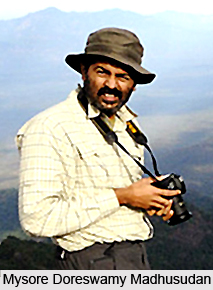 Mysore Doreswamy Madhusudan is a renowned wildlife biologist and ecologist of India. Mysore Doreswamy Madhusudan, Ph.D, is the Co-founder and Director of Nature Conservation Foundation, Mysore. He is also a Visiting Research Fellow at University of Leeds. This renowned conservationist has also worked on understanding and extenuating the effects of human-wildlife inconsistency in the Nilgiri Biosphere Reserve in southern region of India. Mysore Doreswamy Madhusudan has also worked in various other forests in Himalayan region and North-East India. Mysore Doreswamy Madhusudan obtained a science degree from Yuvaraja"s college, Mysore and then completed his post-graduation in wildlife biology from the Wildlife Institute of India, Dehradun. For his PhD thesis he started working on the usage of resources in and around forests and its affect on large mammal preservation. In the year 2004, Mysore Doreswamy Madhusudan was a member of the team of wildlife biologists who discovered Arunachal Macaque, which is a new species of macaque from the state of Arunachal Pradesh.
Mysore Doreswamy Madhusudan is a renowned wildlife biologist and ecologist of India. Mysore Doreswamy Madhusudan, Ph.D, is the Co-founder and Director of Nature Conservation Foundation, Mysore. He is also a Visiting Research Fellow at University of Leeds. This renowned conservationist has also worked on understanding and extenuating the effects of human-wildlife inconsistency in the Nilgiri Biosphere Reserve in southern region of India. Mysore Doreswamy Madhusudan has also worked in various other forests in Himalayan region and North-East India. Mysore Doreswamy Madhusudan obtained a science degree from Yuvaraja"s college, Mysore and then completed his post-graduation in wildlife biology from the Wildlife Institute of India, Dehradun. For his PhD thesis he started working on the usage of resources in and around forests and its affect on large mammal preservation. In the year 2004, Mysore Doreswamy Madhusudan was a member of the team of wildlife biologists who discovered Arunachal Macaque, which is a new species of macaque from the state of Arunachal Pradesh.
Professional Life of Mysore Doreswamy Madhusudan
Mysore Doreswamy Madhusudan unveiled the links between coffee output in Brazil and patterns of livestock grazing and possession in and around the forests of Bandipur. He found out that the worldwide fall in the prices of coffee resulted in a bigger demand for cow dung used in coffee estates in various areas in Nilgiris and Western Ghats. It further resulted in large-scale export of dung changing it from locally produced and consumed manure for agriculture to a high-value organic fertilizer used for industrial export to coffee plantations. Thus, as a result of the dung export, the numbers of livestock in the region increased, which further aggravated the grazing pressures on forests. Thus, this work of Mysore Doreswamy Madhusudan challenged the widespread notion that resource use for subsistence is discernible from and preferable to commercial reserve use in the framework of protected area management in the country.
Awards of Mysore Doreswamy Madhusudan
Mysore Doreswamy Madhusudan received several prestigious awards for his work and contribution towards wildlife conservation in India. In May 2009, he was conferred with the Whitley Award, popularly known as the Green Oscar for his extensive work to decrease human-wildlife conflict in the Western Ghats.



















